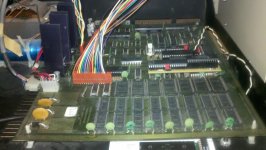Well I got home earlier than expected tonight, and decided to try the petvet that came in today. I've got a Pet 2001 with a 320008 Motherboard.
The normal config that I'm running is no system ram or roms installed, but a Ram/rom board from Nicolas Welte. (It runs ALOT cooler without all those power hungry chips in there.)
I removed my welte board, and grabbed a spare 6502 (3382 Datecode, MOS) and started a quick test.
The first issue I experienced with the pet vet, is a double edged sword. The cpu socket was incredibly tight, and I couldn't get one side on the cpu to sit. I ended up having to remove the cpu and reseat about 3 times to get it, but I do know that that socket should have a GREAT connection to the cpu.
After installing, everything works great, I prefer basic 2, because of the screen snow that 4 causes on original pets.
Loaded and ran a few games, using disk and tape.
The serial header has me a little worried being a straight up and down connector on my board, Most serial cables I have would
be very tall and I would scare me to close the case on them. But a sideways mount also puts alot of weight on one side, that may cause the entire board to become misseated. This requires a bit of thought, but I'm thinking a small extension cable built with idc connectors.
Just my first, quick thoughts on the board, I'll be trying the serial port diags later this weekend.
Later,
dabone


